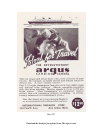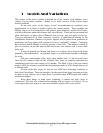Download this book for free at http://www.TheArgusA.com/
8
2 History
The concept of a compact 35mm camera was born in the early 1920s. It was then that
Oscar Barnack of E. Leitz, Inc. developed a portable and accurate camera based on
readily available 35mm film, then the standard for the movie industry. This camera, the
Leica, took the world of amateur photography by storm from the day of its introduction in
1925 at the Leipzig Fair. Encrusted with knobs, dials, levers, and buttons, and not at all
resembling any camera that came before it, the Leica was the ultimate gadget for the rich
and stylish. Cameras were once large obtrusive objects that required considerable
technical knowledge to operate, but with the Leica, amateurs could easily take high-
quality, candid photos, then slip their cameras back into their jacket pockets. Still, the
Leica’s exorbitant price, running up to $200, prevented it from finding its way into the
common man’s hands.
In the early 1930s, the Leica drew the attention of Charles A. Verschoor during a
trip to Europe. Verschoor was an American businessman who, along with other local
businessmen, established a radio manufacturing business in Ann Arbor, Michigan in
1931. International Radio Corporation (IRC) was responsible for the Kadette, the first
AC/DC mantle radio on the market.
Radio first began to mature in the late 1920s, and was considered a sound
investment during the Depression era. For a one-time payment, your radio would play
news, music, or entertainment daily for free! Using a relatively new plastic called
Bakelite to mold the cases, IRC could cheaply produce radios and sell them for a decent
profit.
The problem with radio manufacturing, however, was its reliance on the seasons.
Customers, driven stir-crazy during the winter, would rush outside to meet the spring and,
as a result, radio sales would dwindle until autumn forced consumers indoors again.
Before the advent of air conditioning, people’s behavior was still tied to the weather, and
their spending habits followed. To keep his factory and salesmen working all year,
Verschoor searched for a product that could be cheaply manufactured and sold during the
warmer half of the year. Amateur photography was starting to take hold in America, but
was generally restricted to box-type cameras like the Kodak Brownie and the UniveX A.
Verschoor decided to market an inexpensive Leica-inspired model and set his engineers
to design one.
The Argus was designed to use the new Kodak 35mm daylight loading cartridge.
This film cassette entered the market in late 1934 with the first camera designed to use it,
the Kodak Retina. The new cartridge could be reloaded in a darkroom with surplus
35mm movie film, which was often plentiful and cheap. When Kodak introduced
Kodachrome, the first color film, it was only available as rollfilm in the Kodak 35mm
film cartridge, boosting this film format’s popularity. This cartridge was also the first
that could easily be loaded into a camera in daylight. Such simplicity played a factor in
the success of the Argus. The symbiotic relationship between Argus cameras and
Kodak’s 35mm film cartridges boosted the popularity of both. The Argus A, and its
more famous successor, the Argus C/C2/C3, are the primary reasons that the 35mm film
format was established as firmly as it was, despite the plethora of similar formats that
have been introduced and forced upon photographers in the last seventy years (UniveX
00, Kodak 828, 127, 126, 110, Disc, APS, etc…).


















